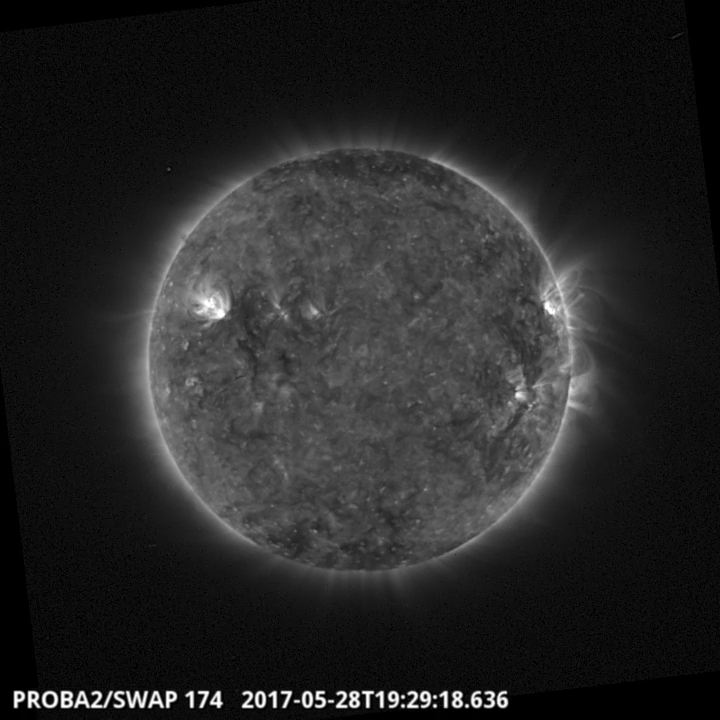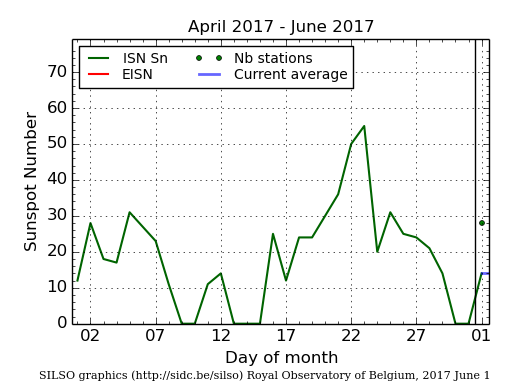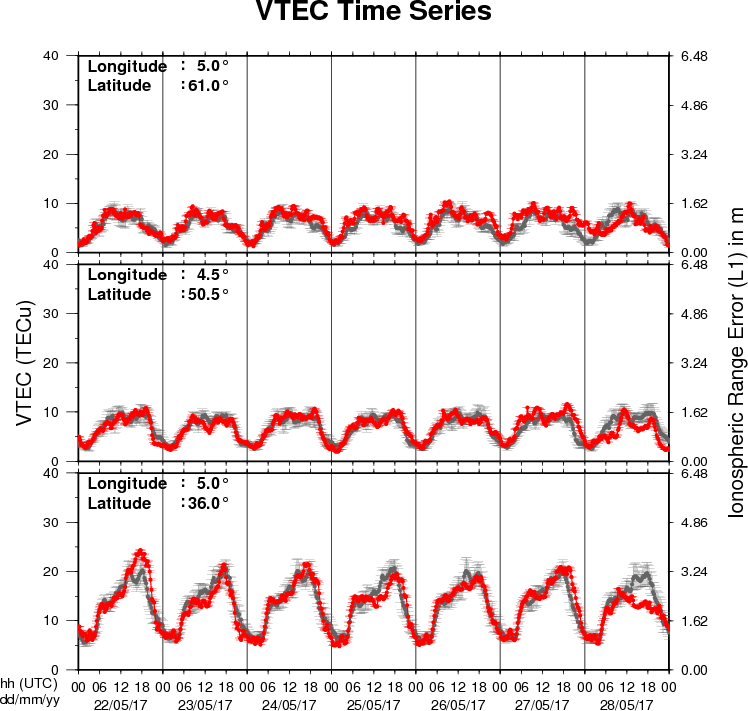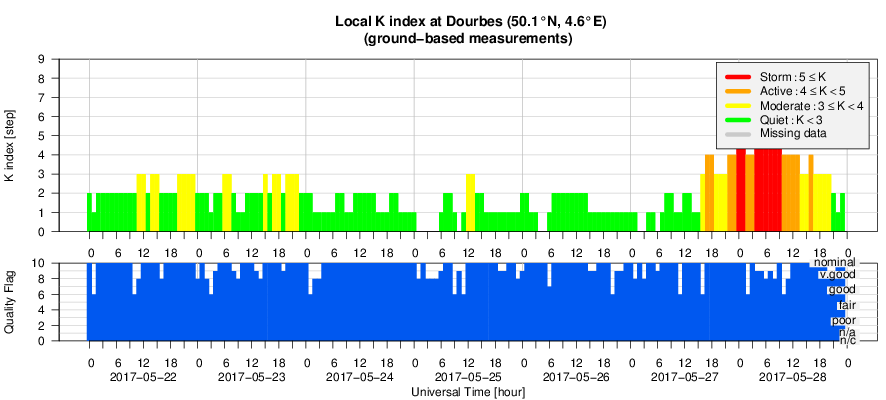- Table of Content
- 1.Extreme Ultrav...
- 2.PROBA2 Observa...
- 3.Review of sola...
- 4.The Internatio...
- 5.Review of geom...
- 6.Geomagnetic Ob...
- 7.Space Weather ...
- 8.Review of iono...
- 9.Future Events
2. PROBA2 Observations (22 May 2017 - 28 May 2017)
3. Review of solar activity (22 May 2017 - 28 May 2017)
4. The International Sunspot Number
5. Review of geomagnetic activity
6. Geomagnetic Observations at Dourbes (22 May 2017 - 28 May 2017)
7. Space Weather Week overview in images
8. Review of ionospheric activity (22 May 2017 - 28 May 2017)
9. Future Events
Extreme Ultraviolet Imager (EUI) ready for launch!
This is it: the solar telescope EUI is ready to be mounted on the Solar Orbiter satellite. Solar Orbiter will be launched in 2019 and will approach the Sun closer than any other satellite ever. Because of its close approach, EUI will be able to make exceptionally detailed images of our star. These will enable scientists to unlock the secrets of the solar atmosphere: why is it so hot, what’s the nature of those magnetic loops and what puts them into motion? EUI will also be the first to image the Sun’s polar regions which are barely visible from Earth.
The EUI telescope was developed by the Centre Spatial de Liège (CSL) and the Royal Observatory of Belgium (ROB), in collaboration with the Belgian industry and foreign partners. Solar Orbiter is a scientific mission led by the European Space Agency (ESA), but also its American counterpart NASA is heavily involved.

Artistic impression of Solar Orbiter
EUI is a scientific camera which will make high-resolution images of the solar atmosphere in non-visible light, i.e. in extreme ultraviolet. The Earth’s atmosphere blocks that light and so it can only be studied from space. The Sun has a completely different outlook in EUV: through magnetic loops, the solar mass is suspended far above the solar surface. These magnetic loops are very dynamic and can suddenly brighten and even burst. If these eruptions are directed towards Earth, they can have severe consequences on our technology such as GPS and radio communication, power grids, and pipelines. EUI offers scientists a unique opportunity to have a close look at the dynamic processes in the solar atmosphere.

EUI OBS flight model ready for delivery
The construction of EUI started already 10 years ago. We have now entered the final phase: the delivery of the instrument to ESA and its integration into the satellite currently under construction. Once EUI and all the other instruments have been assembled, Solar Orbiter will be launched. The satellite then has a long journey ahead before it will reach the right orbit close to the Sun. So it will only be a few years after launch that we can expect the first images and scientists can get to work. We are already looking forward to it!
PROBA2 Observations (22 May 2017 - 28 May 2017)
Solar Activity
Solar flare activity fluctuated between very low and low during the week.
In order to view the activity of this week in more detail, we suggest to go to the following website from which all the daily (normal and difference) movies can be accessed: http://proba2.oma.be/ssa
This page also lists the recorded flaring events.
A weekly overview movie can be found here (SWAP week 374).
http://proba2.oma.be/swap/data/mpg/movies/weekly_movies/weekly_movie_2017_05_22.mp4
Details about some of this week’s events, can be found further below.
If any of the linked movies are unavailable they can be found in the P2SC movie repository here
http://proba2.oma.be/swap/data/mpg/movies/
Sunday May 28

The largest flare of the week was a C3.3 class flare, peaking at 19:28 UT on 2017-Apr-28 produced by the NOAA active region 2656, which is visible in the north-east quadrant of the Sun, close to the limb. This can be seen in the of the SWAP image above.
Find a movie of the events here (SWAP movie)
http://proba2.oma.be/swap/movies/20170528_swap_movie.mp4
Review of solar activity (22 May 2017 - 28 May 2017)
Flares
Solar Activity has increased toward the end of the week. Active Regions NOAA (AR) 2659 and 2660 were the most active, showing continual flux emergence and producing a series of B-class flares the last days of the week. AR 2659 (McIntosh:Dai; Mag.Type:Beta) produced the biggest flare B9.2 peaking at 18:30 UT on 27-May-2017.
NOAA AR 2659 is expected to produce more B-class and C-class flares next week.
A Coronal Mass Ejection
A slow partial halo CME, with projected speed of about 192 km/sm (and reconstructed speed around 320 km/s) and angular width of about 122 degree, was detected at 05:24 UT by CATUS on 23-May-2017. The PROBA2/SWAP images show a strong dimming near solar disk centre. An EUV dimming can be associated with a CME. Based on the Drag Based Model (DBM, http://oh.geof.unizg.hr/DBM/dbm.php) and the location of the EUV dimming, we predicted an arrival time of the CME at Earth around 15:00 UT, 27-May-2017. Indeed, a shock was detected in the solar wind parameters measured by the satellite DSCRV (in the L1 point) at 14:50 UT, 27-05-2017.
Solar Proton Fluxes
Solar proton fluxes measured by the geostationary satellite GOES, remained at background levels over the past week.
The International Sunspot Number

The daily Estimated International Sunspot Number (EISN, red curve with shaded error) derived by a simplified method from real-time data from the worldwide SILSO network. It extends the official Sunspot Number from the full processing of the preceding month (green line). The plot shows the last 30 days (about one solar rotation). The horizontal blue line shows the current monthly average, while the green dots give the number of stations included in the calculation of the EISN for each day.
Review of geomagnetic activity
Solar Wind parameters by DSCVR
Solar wind speed was gradually decreasing till 300 km/s from the beginning of the week until 14:50 UT 27-May-2017, when a small shock was observed in the solar wind due to the arrival of the 23-May-2017 CME. Initially, the solar wind speed abruptly increased from 303 km/s to 385 km/s and the density increased from 4.6 to 70p/cm3. These data are based on DSCVR satellite measurements.
The total Interplanetary Magnetic Field (IMF) Bt jumped from 2.5 to 10 nT, while the Bz component jumped to -8.5 nT. Later on Bt reached a maximum of 22.30 nT at 22:30 UT and Bz component reached -20.5 nT value. Then Bt started to decrease gradually (till 16.5 nT), while Bz slowly returned to low values (-3.5 nT) being strongly negative. Solar wind speed was at relatively low level below 400 km/s.
Later total IMF strength returned to nominal levels, and Bz component slowly returned to near zero and then low positive values at the end of the observational week.
Geomagnetic response - K and Kp
Kp reached moderate storm levels (Kp=6) from 21 UT (27-May-2017) to 03 UT (28-May-2017). During the 3h time interval 03-06 UT (28-05-2017) Kp reached major storm levels (Kp=7) and during 06-12 UT on the same day, Kp reached again moderate and minor storm levels (Kp=6, Kp=5). Local K measured at Dourbes was at minor to major storming levels (K=5,4,5,6,7,5) from 21 UT (27-May-2017) to 12 UT (28-May-2017).
Together with the return of the IMF to nominal levels, the geomagnetic environment returned to very quiet levels (Kp = 1).
Space Weather Week overview in images
These are the slides presented during the Monday May 29 Space Weather Briefing given by the forecaster that was on duty from May 22 to May 28. It reflects in images and graphs what is written down in the Solar and Geomagnetic Activity report in this news letter.

Review of ionospheric activity (22 May 2017 - 28 May 2017)

The figure shows the time evolution of the Vertical Total Electron Content (VTEC) (in red) during the last week at three locations:
a) in the northern part of Europe(N61°, 5°E)
b) above Brussels(N50.5°, 4.5°E)
c) in the southern part of Europe(N36°, 5°E)
This figure also shows (in grey) the normal ionospheric behaviour expected based on the median VTEC from the 15 previous days.
The VTEC is expressed in TECu (with TECu=10^16 electrons per square meter) and is directly related to the signal propagation delay due to the ionosphere (in figure: delay on GPS L1 frequency).
The Sun's radiation ionizes the Earth's upper atmosphere, the ionosphere, located from about 60km to 1000km above the Earth's surface.The ionization process in the ionosphere produces ions and free electrons. These electrons perturb the propagation of the GNSS (Global Navigation Satellite System) signals by inducing a so-called ionospheric delay.
See http://stce.be/newsletter/GNSS_final.pdf for some more explanations ; for detailed information, see http://gnss.be/ionosphere_tutorial.php
Future Events
For more details, see http://www.spaceweather.eu/en/event/future
United Nations/United States of America Workshop on the International Space Weather Initiative in Massachusetts (USA)
Start : 2017-07-31 - End : 2017-08-04
This workshop marks the 10th anniversary of the International
Heliophysical Year, which led to the genesis of the International
Space Weather Initiative. It is organized jointly by the Office for
Outer Space Affairs, the National Aeronautics and Space
Administration (NASA) and Boston College to highlight the
achievements made over the past ten years and to show-case the
worldwide development of science, capacity building, and
outreach.
The UN Workshops on ISWI have been aimed at providing a global
forum for space weather experts from developed and developing
countries, including representatives of the major instrument
operators and data providers. In particular the Workshop will focus
on recent advances made in scientific research by utilizing ISWI
instrument data in conjunction with space mission data in adding
significant new knowledge on space weather phenomena near Earth and
interplanetary space.
The workshop will begin with a high level international forum on
the economic and societal effects of extreme space weather. This
forum will include keynote speakers from major international
organizations followed by a panel session to discuss issues and
policies for acknowledging space weather as a global challenge.
The workshop is also held in preparation for UNISPACE+50 in
2018, the 50th anniversary of the first UN Conference on the
Exploration and Peaceful Uses of Outer Space (UNISPACE), held in
Vienna in 1968. The three components of the Workshop will also help
develop a coherent international policy towards an appropriate
response to space weather.
Website: https://iswi2017.bc.edu/
URSI General Assembly in Montreal, Canada
Start : 2017-08-19 - End : 2017-08-26
For the thirty-second time since the inception of URSI, Radio
Scientists from across the world will get together for the URSI
General Assembly and Scientific Symposium. This triennial gathering
will take place from 19th to 26th of August 2017, in Montreal,
Canada. This conference is a unique opportunity to learn about
recent advances in all fields of Radio Science, as covered by all
ten URSI Commissions.
Among the different sessions, please note:
* 'Radio Science for Space Weather'
Conveners: M. Messerotti, V. Pierrard
* 'Remote Sensing and Modeling of the Earth's Plasmasphere
and Plasmapause'
Conveners: A. M. Jorgensen, V. Pierrard, B. Heilig
The abstract deadline is 30 January 2017
Website: http://www.ursi2017.org
2017 Joint IAPSO-IAMAS-IAGA Assembly in Cape Town, South Africa
Start : 2017-08-27 - End : 2017-09-01
The Joint IAPSO-IAMAS-IAGA Assembly, endorsed by the University
of Cape Town and the South African Department of Science and
Technology, will take place from 27 August to 1 September 2017 at
the Cape Town International Convention Centre (CTICC). Several IAGA
and IAMAS sessions are of Space Weather interests as well as the
joint session 'Space Weather throughout the Solar System: Bringing
Data and Models together'.
Website:
http://iapso-iamas-iaga2017.com/index.php
Workshops on Radiation Monitoring for the International Space Station in Torino, Italy
Start : 2017-09-05 - End : 2017-09-07
The Workshop on Radiation Monitoring for the International Space
Station is an annual meeting to discuss the scientific definition
of an adequate radiation monitoring package and its use by the
scientific community on the ISS. Types of instruments and research
topics need to be defined in order to optimise the radiation safety
of the ISS crew.
Website: http://wrmiss.org/
International Workshop on Solar, Heliospheric & Magnetospheric Radioastronomy in Meudon, France
Start : 2017-11-06 - End : 2017-11-10
Jean-Louis Steinbeg has been one of the major pioneers in
radioastronomy. Co-founder of the Nançay Observatory, he
has actively participated to, an inspired a large number of radio
instruments on many international space missions. Jean-Louis
Steinberg is the founder of the Space Radioastronomy laboratory of
the Paris Observatory in 1963. Later on, this laboratory widened
its science interests and became the DESPA (1971) and then the
current LESIA (2002) which is one of the major space sciences
laboratories in France. The aim of this workshop is to cover the
science topics which Jean-Louis Steinberg has promoted during his
career, focusing on Solar, Heliospheric & Magnetospheric
radioastronomy & physics. This will be done by covering both
observations from either ground facilities (NDA, RH, LOFAR, Artemis
etc ...) or space missions (ISSEE, Ulysses, WIND, CLUSTER, STEREO,
CASSINI, JUNO etc ...) and models/theories. A series of invited
talks is also foreseen to cover the new developments in the
discipline which may come with the future facilities such as Solar
Orbiter, Solar Probe Plus, JUICE, JUNO, LOFAR+, SKA etc ....
This workshop will also be the opportunity to remember both the
extraordinary personal & professional lifes of Jean-Louis
Steinberg especially for new generation of scientists. At the
occasion of this workshop it is also expected that the Building 16
(historical Space Sciences building) on the Meudon campus will be
renamed "Building Jean-Louis Steinberg".
Website:
https://jlsworkshop.sciencesconf.org/
European Space Weather Week 14
Start : 2017-11-27 - End : 2017-12-01
The ESWW is the main annual event in the European Space Weather
calendar. It is the European forum for Space Weather as proven by
the high attendance to the past editions. The agenda will be
composed of plenary/parallel sessions, working meetings and
dedicated events for service end-users. The ESWW will again adopt
the central aim of bringing together the diverse groups in Europe
working on different aspects of Space Weather.
Website:
http://www.stce.be/esww14/
